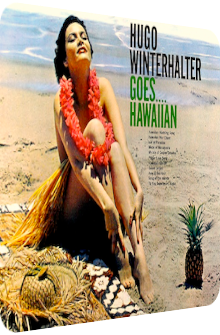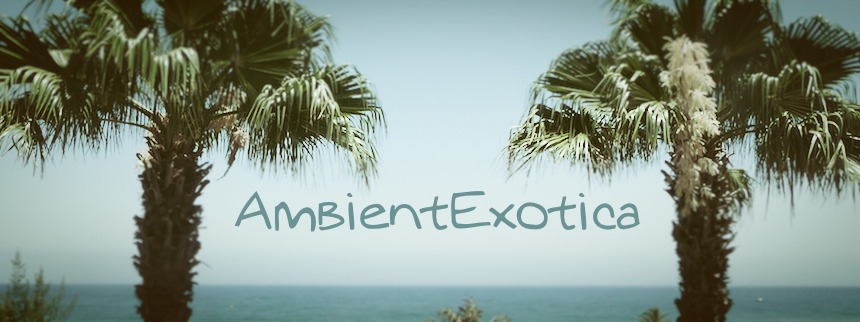
Hugo Winterhalter Goes...
Hawaiian
1961
Vivid arranger and composer Hugo Winterhalter’s (1909–1973) Goes To… series of travelogs is one of the better known Easy Listening artifacts out there that try to encapsulate a sense of adventure, globetrotting and cosmopolitan knowhow. It is a direct competitor to Werner Müller’s Holiday In… series, with both of them leading to a win-win situation for fans of the genre, each stellar in their own right. Over the course of its run, Winterhalter and his orchestra have aurally visited many a destination and place, be it Mexico (1961) or even a gypsy cymp (1960). Unsurprisingly, Goes… Hawaiian is the tropical epiphany, or so it seems. What else could it be, featuring eleven string-fueled Hapa Haole standards and one unique piece from the composer himself. Released in 1961 on RCA Victor, the Hawaiian episode should therefore cater to the Exotica fan as best it can. This, however, is not necessarily the case. While Winterhalter does not harm the melodies themselves, with each of these classics remaining recognizable and its tone sequences fully enjoyable, there is a certain treat that should be most welcome, but has also quite a deconstructionist attitude: unusual instruments. They are not unusual per se: droning timpani or a piano that is played as if it was standing in a smoke-filled bar are very common things indeed… albeit not in the specific context of Hawaiiana or Hapa Haole. This makes some arrangements a hit-or-miss affair, but over the course of both sides, this works out pretty well quite a lot. And yet: is Goes… Hawaiian a failed entry after all?
Like a mixture between a pompous timpani-accentuated Bert Kaempfert sunrise and a Billy Vaughn mirage, Hugo Winterhalter’s first stop is situated in-between these climes: Hawaiian Wedding Song by Charles E. King, Al Hoffman and Dick Manning is schmaltzier than the Hawaiiana fan wants it to be. The ukulele strumming and steel guitar glissando are on board alright, but the whitewashed brass haze is too featureless. However, there’s one tiny hint of the things to come: the last three string streams fuse the lilac hope for a half-ethereal adventure akin to Don Tiare’s Strings Over Hawaii (1963). Up next is the Hawaiian War Chant, presented here as usual in Johnny Noble’s transcription of Prince Leleiohoku’s Hapa Haole gold standard. The drums are revved up, with the timpani bursting at the seams. Jazzy cocktail vibes round off the brass-underlined insouciance. Even a muted lead trumpet is on board, exuding a femme fatale shadiness that adds a new scheme to this classic. Watch out for the superbly warped downwards-spiraling steel guitar chords in the last third!
Isle Of Paradise is it: Hugo Winterhalter’s own concoction. One of these originals is always featured in his series of travelogs. This ditty turns out to be a slow Waltz with soothingly shuffling horn helixes, orchestra bell polka dots and a silken veil that wafts around the ukulele licks. This is your archetypically bland Easy Listening theme, true, but the textures are all compatible with each other, making it possible to enjoy the euphony against all odds. Alfred Newman’s and Frank Loesser’s classic Moon Of Manakoora meanwhile succeeds with wonderfully faux-Oriental alto flute cascades that are juxtaposed to a dreamy ukulele and lots of interstitial phases of placidity before the strings hit big time in the second half. My Isle Of Golden Dreams by Gus Kahn and Walter Blaufuss then pinpoints the antediluvian but sugar-sweet spirit of Hapa Haole as seen through Hollywood glasses: saccharified strings and paradisiac horns evoke the insular carefreeness with a little help of a ukulele, whereas the interim finale Pagan Love Song by Nacio Herb Brown and Arthur Freed resulting in a great hybrid: mellifluous string washes and seven-note flute pirouettes meet scything dark matter horn eruptions that wouldn’t be out of place in Yma Sumac’s Mambo! (1953) at all.
Side B tries to cajole its way to the ears of the connoisseur with five additional pieces of dazzling island hue. Roy Bennett’s and Sid Tepper’s Hawaiian Sunset marks the appearance of the first surprise, no matter the standardized title, for it is actually less considered in the outer rims of Exotica. Hugo Winterhalter places a Honky Tonk piano in 6/8 time and surrounds it with turbulent horns and serrated strings. The endeavor is noticeable, but alas, the surfaces do not fit well together, making this some sort of a mutation instead of a mere transmutation. Harry Owens’ Sweet Leilani however turns out to be a boon. Mountainous horns and cautious timpani form the bokeh backdrop for the strings and ukulele interaction in the foreground, letting the well-known melody appear in a new Space-Age light, with the adjacent Now Is The Hour by Clement Scott and Dorothy Stewart feeling like a Baroque lullaby. Romanticism is in the air, the strings and nocturnal bells are oh so languorous, but eminently standardized, lacking the vibe of Hawaii. With Charles E. King’s Song Of The Islands, Winterhalter tries to rectify the situation by adding another bunch of Crime Jazz horns to the clarinet-accompanied string cataract, all the while Harry Owens’ second piece To You Sweetheart, Aloha introduces pizzicato strings in the very last moment of this LP. Liquedous, with superbly ghostly ukulele strings and droning timpani, this bland piece is spiced quite a bit, but keeps its equanimity.
When Hugo Winterhalter Goes… Hawaiian, you might as well stay at home. Not because he brings the spirit to Hawaii to your abode in the shape of 12 inch vinyl, but because this is what he does not do with this record! I consider his series of travelogs well worth any Exotica listener’s while when two premises are a given: the listener ought to enjoy string-focused Easy Listening, and in addition needs to be at least aware of the Hawaiian material out there, be it "only" through Arthur Lyman and Martin Denny renditions or not. Hugo Winterhalter’s vision of Hawaii is not bad at all. In fact, one can admire the addition of antimatter or unusual textures such as Crime Jazz timbres and the reappearance of the timpani. The textures, however, are not necessarily compatible at all times, making it hard to enjoy the, say, Honky Tonk atmosphere during Hawaiian Sunset. The melodies are all recognizable and faithfully embedded, but the strings and horns are too mucoid and bland most of the time. When the string washes rise and become feistier, for example in the arrangement of Pagan Love Song, the album grows and spawns a certain euphoria. Its remainders are bog-standard though, making Goes Hawaiian… the least exotic diorama of Winterhalter’s travelog expertise. It is nevertheless available in digital form at iTunes, Amazon and Co., so there is no excuse to not give it a go and pre-listen to its material.
Exotica Review 460: Hugo Winterhalter – Goes… Hawaiian (1961). Originally published on Nov. 21, 2015 at AmbientExotica.com.
